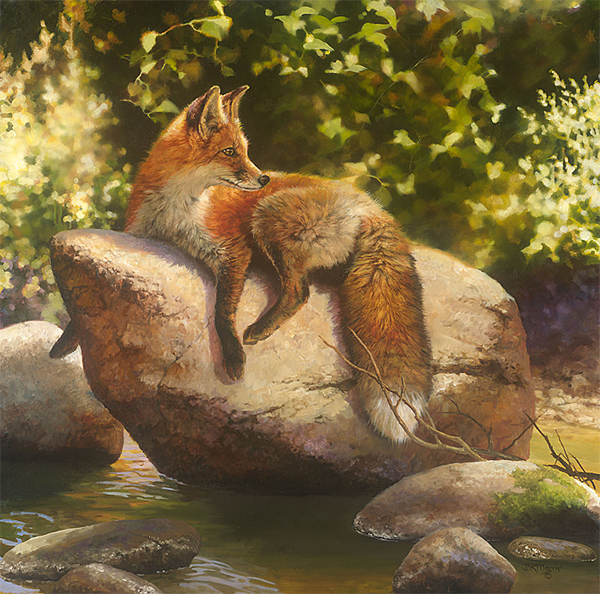
On that gray day there came a shower
that swept across the weathered glade.
Upon the edge, deep in a bower,
small chickadees began to play.
Straw fledgling nest was dry and shaded,
tall grasses brown and old vines faded.
And deep within that meadow home,
tucked underneath a cloudy dome,
sweet songs were heard from church bell towers;
soft notes in undulating tones
mixed smoothly with the buzzing drones
of honey bees in search of flowers.
And there began that autumn day,
an old red fox to hunt his prey.
In deep ruts left by wagon courses,
along a dusty country lane,
mixed with the earthy smell of horses,
old scents lay muted by old rain.
Fox followed trails among wild brambles
of cottontails’ divergent rambles.
Then as he heard a crowing cock,
and watched a farmer feed his flock,
he laid his plans in stealth and waited,
until the master went away.
Inside the pen Old Fox held sway
entire brood mauled and decimated.
And there as he consumed his feast,
Old Fox became the hunted beast.
Upon that crisp, cold autumn morning,
arose the Master of the Quorn,
gave Old Red Fox his due forewarning,
by calling men with hunting horn.
In jackets of a bright red luster,
each man responded to the muster.
Hounds milled about the master’s court,
an eager, sniffing, restless sort.
Destroying vermin in the village
was the purpose of the chase.
Each man expected to keep pace;
intent on ending Old Red’s pillage.
But, sly Old Fox could not be found,
he’d hidden deeply, gone to ground.
|
Author Notes
In England, the Quorn is the oldest and most prestigious Fox Hunt.. The Master of the Quorn is the leader of the chase.
Gone to ground is a hunting term about the quarry hiding underground.
The Onegin stanza or Pushkin sonnet refers to a verse form, created by the Russian poet Alexander Pushkin in the 19th century, to be the vehicle for his verse novel Eugene Onegin (Oh-knee-gin with a hard G). Later this was made into an opera by Tchaikovsky. The work was mostly written in iambic tetrameter with the usual substitutions allowable. The rhyme scheme aBaBccDDeFFeGG, where the lowercase letters represent feminine endings (i.e., with an additional unstressed syllable) and the uppercase representing masculine ending (i.e. stressed on the final syllable). It is important that this should be maintained as it is the signature to the form
Unlike other traditional sonnet forms, the Onegin stanza does not divide into smaller stanzas of four lines or two in an obvious way. There are many different ways the sonnet can be divided: for example, the first four lines can form a quatrain, or instead join with the "cc" to form a sestet. The form's flexibility allows the author more scope to change how the semantic sections are divided from sonnet to sonnet, while keeping the sense of unity provided by following a fixed rhyme scheme. The presentation is always as a single stanza of fourteen lines. Also, being written in iambic tetrameter imparts a stronger sense of motion than other sonnets, which use the more common iambic pentameter.
If used as a stand-alone poem then the form gets known as the Pushkin Sonnet, named after the originator. If the fourteen lines are used as a stanza in a longer work, to which it is well suited the form becomes known as the Onegin Stanza.
|





